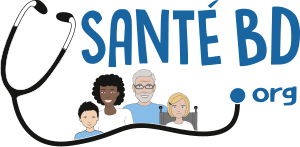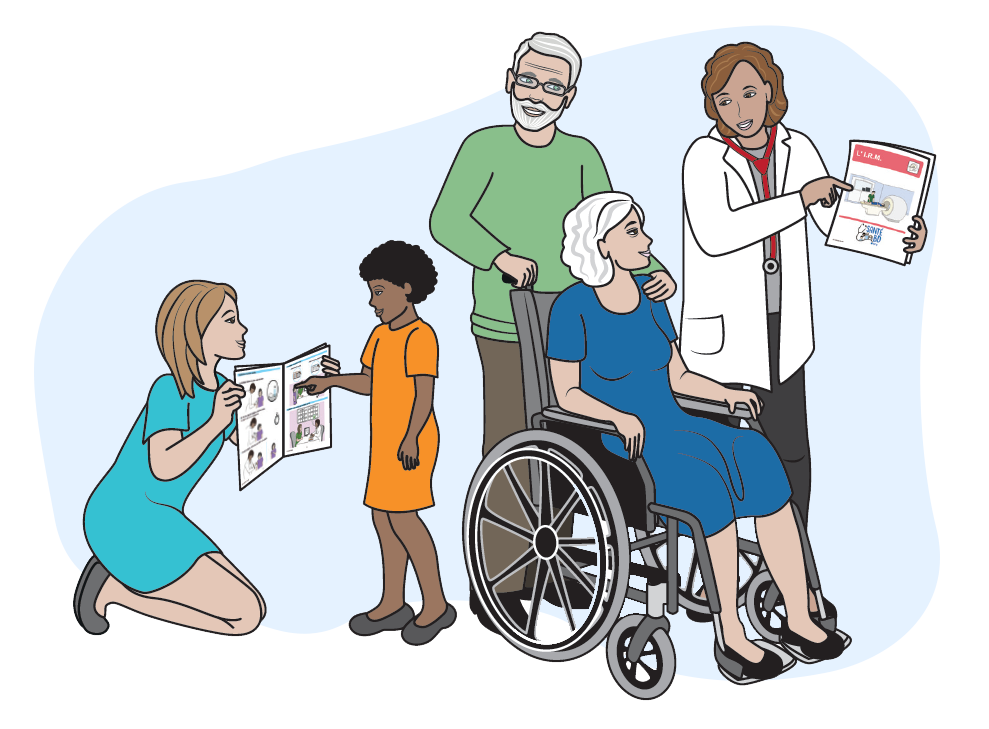Transcription textuelle de la BD Going to the doctor
Why ?
I need to go at least once a year for a checkup.
I can go if :
I have a fever.
I have a headache.
An area of my face hurts.
- The throat
- The ears
- The eyes
- The nose
A part of my body hurts.
- Stomach
- Back
- Arm
- Leg
I have skin problems.
- Itching
- Red patches
- Spots
- Wound
I have another problem.
- I have an injury.
- I have a cough.
- I can’t hear well.
I have another problem.
- I’m vomiting.
- I’m constipated.
- I have diarrhea.
I don’t feel well.
- I feel sad.
- I have trouble sleeping.
- I don’t have any appetite.
- I’m very tired.
I point to where it hurts
- Front
- Back
I need to see a doctor for :
- a prescription
- medical approval
- a vaccination
What happens when I’m there ?
The doctor greets me.
I can go by myself
or with another person.
The doctor asks me questions to find out why I came.
He writes things down in my medical file.
The doctor measures me.
I stand against the wall.
My heels touch the wall.
I hold my head straight.
The doctor touches my hair with the measuring device.
The doctor weighs me.
I step on the scale.
The doctor can ask me to take off some pieces of clothes.
- Top
- Bottom
- Top and bottom
The doctor asks me to sit down on the examining table.
It’s a table that looks like a tall bed.
The doctor can examine me in different positions.
- Standing up
- Sitting down
- Lying down
The doctor can touch me when looking for pain or a growth.
He puts his hands on a part of my body.
He can press hard.
He asks if it hurts.
The doctor takes my blood pressure.
To take my blood pressure, the doctor uses a blood pressure monitor.
I extend my arm and the doctor presses on the pump to inflate the armband.
The armband tightens around my arm and it feels uncomfortable.
This lasts a few minutes, then the armband is deflated.
The doctor examines me to listen for sounds in my body.
To examine me the doctor uses a stethoscope.
The doctor puts it in his ears.
He then places the stethoscope on :
- my chest
- my neck
- my stomach
- my back
The doctor can ask me to :
- breathe in deeply with my mouth open
- cough
- hold my breath
The doctor looks at my throat.
He uses a tongue depressor and a light.
He asks me to open my mouth.
He presses down on my tongue with the tongue depressor.
He looks at the back on my mouth with his light.
Sometimes he puts a cotton swab deep in my throat
The doctor looks in my ears.
He uses a kind of a small funnel.
It is called an otoscope.
He puts the otoscope in my ear.
The doctor is very close to my cheek.
To see better, he gently pulls on my ear.
The doctor takes my temperature.
- under the arm
- or on my forehead
- or in my ear
The doctor can give me a vaccine shot.
So it doesn’t hurt, I can numb my skin two hours before by putting on :
- some anesthetic pomade. I put on the pomade. I cover it with a bandage.
- or an anesthetic patch. It is like a large bandage.
The doctor cleans my skin with a cotton swab.
He gives me the shot.
The doctor puts on a bandage.
The exam is over
I get dressed and the doctor explains everything to me.
The doctor can give me :
- A prescription for medication
- A letter to see a specialist
- A sick leave notice
- A request for medical exams
Everything I say to the doctor remains a secret between us.
I can say anything.
SantéBD Multilingual is a project supported by the Orange Foundation.
SantéBD booklets?
- On the internet: Visit the website: www.santebd.org
- On the SantéBD Channel Youtube
SantéBD booklets are free.
SantéBD is a project by the NGO Coactis Santé contact@santebd.org
SantéBD booklets are produced in partnership with different participants from the world of healthcare and working with disabilities. Illustrations by Frédérique Mercier.
Copyright Coactis Santé
The creation of this tool was made possible with the support of:
- la Fondation Handicap Malakoff Humanis
- la Fondation de France
- la mairie de Paris
- l’Assurance maladie
- la Caisse nationale de solidarité pour l’autonomie
- Santé publique France
This document was proofread by people with learning disabilities and respects the European Easy-to-Read Guidelines. These guidelines help to make information available for everyone.
For more information visit the website https://www.inclusion-europe.eu/easy-to-read/





